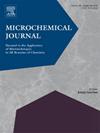用于灵敏检测黄曲霉毒素 B1 的光热和表面增强拉曼散射双模式免疫层析传感器
IF 4.9
2区 化学
Q1 CHEMISTRY, ANALYTICAL
引用次数: 0
摘要
多模式侧向流免疫分析法在提高床旁检测的灵活性和实用性方面具有巨大潜力。本研究开发了一种双模式光热(PT)和表面增强拉曼散射(SERS)免疫层析传感器,用于灵敏检测黄曲霉毒素 B(AFB)。制备了负载 5,5′-二硫代双(2-硝基苯甲酸)(DTNB)的双功能蜡梅样核卫星纳米粒子,并与抗体偶联形成 PT@SERS 纳米探针,用于定性和定量检测 AFB。纳米探针的光热转换效率和 SERS 增强因子分别为 42.11 % 和 1.59 × 10。在最佳条件下,PT 法的检测限为 0.033 ng/mL,线性范围为 0.05-10 ng/mL(R = 0.997);SERS 法的检测限为 0.0073 ng/mL,线性范围为 0.005-10 ng/mL(R = 0.998)。特异性分析结果表明与其他毒素没有交叉反应。玉米和花生的加标回收率分别为 85.39 % 至 112.15 %(PT 法)和 80.04 % 至 106.57 %(SERS 法)。检测结果表明,所开发的双模式传感器为实现 AFB 的快速检测提供了一种可行的选择。本文章由计算机程序翻译,如有差异,请以英文原文为准。
A dual-mode immunochromatographic sensor with photothermal and surface-enhanced Raman scattering for sensitive detection of aflatoxin B1
Multimodal lateral flow immunoassay has displayed the great potential to improve the flexibility and practicality of point-of-care testing. Herein, this study developed a dual-mode photothermal (PT) and surface-enhanced Raman scattering (SERS) immunochromatographic sensor for sensitive detection of aflatoxin B (AFB). The bifunctional waxberry-like core-satellite nanoparticles loaded with 5,5′-Dithiobis (2-nitrobenzoic acid) (DTNB) were prepared and coupled with antibody to form PT@SERS nanoprobes for qualitative and quantitative detection of AFB. The photothermal conversion efficiency and SERS enhancement factor of the nanoprobes were 42.11 % and 1.59 × 10, respectively. Under the optimal conditions, the limit of detection of PT assay was 0.033 ng/mL with a linear range of 0.05–10 ng/mL (R = 0.997); the limit of detection of SERS assay was 0.0073 ng/mL with a linear range of 0.005–10 ng/mL (R = 0.998). The results of the specificity analysis indicated no cross-reactions with the other toxins. The recoveries of the spiked corn and peanut were from 85.39 % to 112.15 % (PT assay) and 80.04 % to 106.57 % (SERS assay), respectively. The assay demonstrated that the developed dual-mode sensor provided a promising option for achieving the rapid detection of AFB.
求助全文
通过发布文献求助,成功后即可免费获取论文全文。
去求助
来源期刊

Microchemical Journal
化学-分析化学
CiteScore
8.70
自引率
8.30%
发文量
1131
审稿时长
1.9 months
期刊介绍:
The Microchemical Journal is a peer reviewed journal devoted to all aspects and phases of analytical chemistry and chemical analysis. The Microchemical Journal publishes articles which are at the forefront of modern analytical chemistry and cover innovations in the techniques to the finest possible limits. This includes fundamental aspects, instrumentation, new developments, innovative and novel methods and applications including environmental and clinical field.
Traditional classical analytical methods such as spectrophotometry and titrimetry as well as established instrumentation methods such as flame and graphite furnace atomic absorption spectrometry, gas chromatography, and modified glassy or carbon electrode electrochemical methods will be considered, provided they show significant improvements and novelty compared to the established methods.
 求助内容:
求助内容: 应助结果提醒方式:
应助结果提醒方式:


